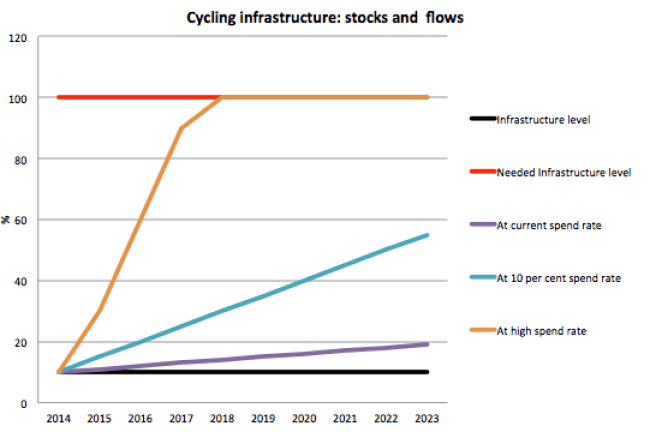Melbourne’s weather is poor. It rains often. The city is huge – 100 km from edge to edge – and vast swathes of it are covered in the kind of densely packed contour lines that make cyclists legs tremble.
In winter, Melbourne’s cycling community shrinks by over a third.
On days like today I suspect the number of cyclists is far smaller.
In short, Melbourne will never be the sort of city where 50 per cent of trips are possible by bike. Cycling (and walking) will never ever do the “heavy lifting” in our transport mix. That role will always be split between public transport and private motorised transport.
At the moment, the mode share split between these three is:

And the trends are these:
Cycling is growing fast, more than doubling in eight years.:

Public transport growth has been its highest in sixty years, with train travel accounting for most of the increase:

And vehicle kilometres have surged on freeways, while not increasing on arterial roads.

Expenditure on specific infrastructure looks like this:
Nationwide, spending on cycling is $112.8 million. Spending on roads is over 100 times more, at $18 billion.

The data is tough to aggregate, but one estimate is that roads get four times the investment of public transport.
All the modes are growing. How do we decide what the data means? And why not let the market decide what modes live or die?
The answer to the second question is that transport is going to be a centrally planned space until we can charge users per kilometre.
Public roads built to accommodate cars push the whole investment process into the world of “second-best.” If subsidising roads is a given, subsidising public transport can be efficient. Subsidising public transport makes policy makers wonder if there are other, cheaper ways to move people around, like bikes.
So if we’re going to be centrally planning our transport mix, we must ask: do we like the current 78/17/5 mix?
I’d argue we should not. I’d argue we should be aiming to grow the share of modes that have fewer negative externalities and greater returns to scale.
I’d hazard a guess that for Melbourne, 10 per cent share evenly split between walking and bike, 30 per cent for public transport, and 60 per cent for cars would be optimal.
Does that mean we should start spending 10 per cent of infrastructure funding on active modes, 30 per cent on public transport and 60 per cent on cars?
Only if we want to move very very slowly.
Infrastructure lasts a long time. That means the stock of existing infrastructure is the single biggest determinant of infrastructure in five years time. Marginal changes in expenditure rates affect outcomes only very gently. If we want to effect change, we need to tip the scales massively in favour of the modes we want to grow, in the short term.
That means that announcements like $650,000 for changes to a cycling bridge in Melbourne’s west should not be cause for widespread congratulation.
In the short term, we could probably usefully spend 60 per cent of the transport infrastructure budget on public transport and 15 per cent on active modes. If we did that for a few years, we would move swiftly towards the outcomes we want, before returning to a “maintenance” split, where expenditure is based on usage.
Spending even $500 million a year on bicycle infrastructure might seem like a lot when the recent budget has been around $30 million. But when you look at what passes for “bicycle infrastructure” and imagine replacing it with global quality bicycle infrastructure, it would be a drop in the ocean.

I don’t imagine gold-plated bicycle infrastructure should go everywhere. Far from it. Cycling infrastructure should be optimised in the areas where cycling can thrive, likely to be areas that already see some bicycle traffic. Fixing missing links, creating Copenhagen lanes on major on-road routes, plus widening and lighting off-street bicycle paths would be the top three priorities.
If we want to increase the share of some modes, we need to be bold about throwing money at them, and not be afraid to acknowledge that such a move comes at the expense of other modes.






 This is
This is 







